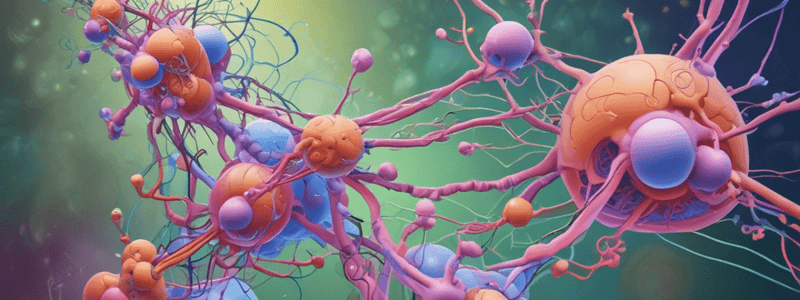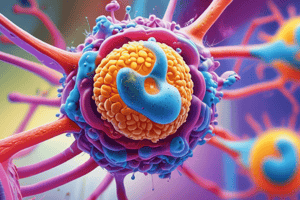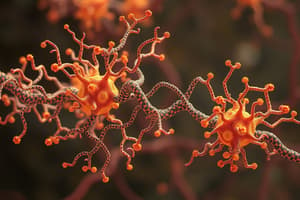Podcast
Questions and Answers
Where are G-protein coupled receptors typically found?
Where are G-protein coupled receptors typically found?
- Viruses
- Prokaryotes
- Eukaryotes (correct)
- Fungi
What percentage of modern medicinal drugs target GPCRs?
What percentage of modern medicinal drugs target GPCRs?
- 30 to 50% (correct)
- 10 to 20%
- 50 to 70%
- 20 to 30%
What is unique about the structure of GPCRs?
What is unique about the structure of GPCRs?
- They have nine transmembrane alpha sheets
- They have seven transmembrane alpha helices (correct)
- They have three transmembrane beta helices
- They have five transmembrane beta sheets
What is another name for GPCRs based on their structure?
What is another name for GPCRs based on their structure?
What is the function of GPCRs in the body?
What is the function of GPCRs in the body?
What type of compounds can bind to GPCRs?
What type of compounds can bind to GPCRs?
What is the significance of GPCRs in research?
What is the significance of GPCRs in research?
What award was given for research on GPCRs in 2012?
What award was given for research on GPCRs in 2012?
What is the primary function of G-proteins?
What is the primary function of G-proteins?
What is the composition of G-proteins associated with GPCRs?
What is the composition of G-proteins associated with GPCRs?
What is the purpose of lipid anchors in G-proteins?
What is the purpose of lipid anchors in G-proteins?
What is the result of a G-protein binding GTP?
What is the result of a G-protein binding GTP?
What is the role of the GPCR in the signaling pathway?
What is the role of the GPCR in the signaling pathway?
What is the result of the ligand binding to the GPCR?
What is the result of the ligand binding to the GPCR?
What is the function of the alpha subunit in the signaling pathway?
What is the function of the alpha subunit in the signaling pathway?
What is the purpose of the beta and gamma subunits in the signaling pathway?
What is the purpose of the beta and gamma subunits in the signaling pathway?
What is the ultimate outcome of the G-protein signaling pathway?
What is the ultimate outcome of the G-protein signaling pathway?
What is the order of the steps in the G-protein signaling pathway?
What is the order of the steps in the G-protein signaling pathway?
What occurs when the alpha subunit binds to a target protein?
What occurs when the alpha subunit binds to a target protein?
What is the result of the hydrolysis of GTP to GDP?
What is the result of the hydrolysis of GTP to GDP?
What is the role of the RGS protein?
What is the role of the RGS protein?
What is the function of adenylate cyclase?
What is the function of adenylate cyclase?
What is the effect of cyclic AMP on the body?
What is the effect of cyclic AMP on the body?
What happens to the alpha subunit when the GTP is hydrolyzed to GDP?
What happens to the alpha subunit when the GTP is hydrolyzed to GDP?
What is the role of the beta-gamma subunits?
What is the role of the beta-gamma subunits?
What is the result of the binding of epinephrine to the adrenergic receptor?
What is the result of the binding of epinephrine to the adrenergic receptor?
What is the purpose of the G-protein signaling pathway?
What is the purpose of the G-protein signaling pathway?
What is the final result of the G-protein signaling pathway?
What is the final result of the G-protein signaling pathway?
Flashcards are hidden until you start studying
Study Notes
G-Protein Coupled Receptors (GPCRs)
- GPCRs are only found in eukaryotes and comprise the largest known class of membrane receptors.
- There are over 1,000 known different types of GPCRs in humans, each specific to a particular function.
Structure of GPCRs
- GPCRs have seven transmembrane alpha helices, which is a unique and important characteristic.
- They are often also referred to as "7 transmembrane receptors" due to this structural feature.
Interaction with G-Proteins
- GPCRs interact with G-proteins, which are specialized proteins that can bind GTP and GDP.
- The G-proteins that associate with GPCRs are heterotrimeric, meaning they have three different subunits: alpha, beta, and gamma.
Signaling Pathway
- The signaling pathway of GPCRs involves a ligand binding to the receptor, causing a conformational change.
- The conformational change triggers the exchange of GDP for GTP on the alpha subunit, which then dissociates and regulates target proteins.
- The alpha subunit and beta-gamma dimer can interact with other proteins to relay messages, leading to a range of downstream effects.
Steps of the Signaling Pathway
- Step 1: Ligand binds to the GPCR
- Step 2: GPCR undergoes a conformational change
- Step 3: Alpha subunit exchanges GDP for GTP
- Step 4: Alpha subunit dissociates and regulates target proteins
- Step 5: Target protein relays a signal, leading to a range of downstream effects
- Step 6: GTP is hydrolyzed to GDP, returning the system to its original state
Regulation of G-Protein Signaling
- The system can be regulated by RGS proteins, which accelerate the hydrolysis of GTP to GDP.
Example of GPCR Function
- The binding of epinephrine (adrenaline) to an adrenergic receptor (a type of GPCR) triggers a signaling pathway that leads to an increase in heart rate, dilation of skeletal muscle blood vessels, and breakdown of glycogen to glucose.
Importance of GPCRs
- GPCRs are a large and diverse family of cell surface receptors that respond to many different external signals.
- They play a crucial role in regulating a wide range of bodily functions, including sensation, growth, and hormone response.
Studying That Suits You
Use AI to generate personalized quizzes and flashcards to suit your learning preferences.




